An Ecoregional Conservation Assessment for the Northern Rockies Ecoregion and Proposed Climate Refugium in the Yaak River Watershed, USA
Abstract
1. Introduction
2. Materials and Methods
2.1. Study Area
2.2. Mapping Methods
2.3. Land Ownership and GAP Status
2.4. Existing Vegetation Types
2.5. Forest Structural Maturity Classes
2.6. Focal Wildlife Species Habitat Suitability
2.7. Fire, Wildland–Urban Interface, and Mechanical Fuel Treatments
2.8. Climate Change Analysis
3. Results
3.1. Landownerships and Conservation Targets
3.2. Existing Vegetation Types and Conservation Targets
3.3. Mature Forests and Conservation Targets
3.4. Focal Mammal Species Habitat Suitability and Conservation Targets
3.5. Focal Avian Species Habitat Suitability and Conservation Targets
3.6. Wildland Urban Interface and Fuel Treatments
3.7. Historical vs. Projected Climate Change Under the Intermediate vs. Very High Emission Scenarios
4. Discussion
4.1. Representation Targets for EVT, Focal Species, and Mature Forests
4.2. Wildfires and the Wildland–Urban Interface
4.3. Climate Change and Refugia
5. Conclusions
Supplementary Materials
Author Contributions
Funding
Data Availability Statement
Acknowledgments
Conflicts of Interest
References
- Dinerstein, E.; Olson, D.; Joshi, A.; Vynne, C.; Burgess, N.D.; Wikramanayake, E.; Hahn, N.; Palminteri, S.; Hedao, P.; Noss, R.; et al. An Ecoregion-Based Approach to Protecting Half the Terrestrial Realm. BioScience 2017, 67, 534–545. [Google Scholar] [CrossRef]
- Balantic, C.; Adams, A.; Gross, S.; Mazur, R.; Sawyer, S.; Tucker, J.; Vernon, M.; Mengelt, C.; Morales, J.; Thorne, J.H.; et al. Toward Climate Change Refugia Conservation at an Ecoregion Scale. Conserv. Sci. Pract. 2021, 3, e497. [Google Scholar] [CrossRef]
- Convention on Biological Diversity Kunming-Montreal Global Biodiversity Framework 2022. Available online: https://www.developmentaid.org/api/frontend/cms/file/2024/11/iucn-issues-brief-gbf-update-final.pdf (accessed on 4 May 2025).
- Omernik, J.M. Ecoregions of the Conterminous United States. Ann. Assoc. Am. Geogr. 1987, 77, 118–125. [Google Scholar] [CrossRef]
- Ricketts, T.H.; Dinerstein, E.; Olson, D.M.; Loucks, C.J.; Eichbaum, W.; Latham, J. Terrestrial Ecoregions of North America: A Conservation Assessment; Island Press: Washington, DC, USA, 1999. [Google Scholar]
- NatureServe. Northern Rocky Mountain Dry-Mesic Montane Mixed Conifer Forest. Available online: https://explorer.natureserve.org/Taxon/ELEMENT_GLOBAL.2.722868/Northern_Rocky_Mountain_Dry-Mesic_Montane_Mixed_Conifer_Forest (accessed on 25 January 2025).
- One Earth. Northern Rockies Conifer Forests. Available online: https://www.oneearth.org/ecoregions/northern-rockies-conifer-forests/ (accessed on 5 November 2024).
- Potter, K.M.; Conkling, B.L. Forest Health Monitoring: National Status, Trends, and Analysis 2022; U.S. Department of Agriculture, Forest Service, Southern Research Station: Asheville, NC, USA, 2023; p. SRS-GTR-273.
- Chester, C.C.; Hilty, J.A. The Yellowstone to Yukon Conservation Initiative as an Adaptive Response to Climate Change. In Handbook of Climate Change and Biodiversity; Springer: Cham, Switzerland, 2018; pp. 179–193. ISBN 978-3-319-98681-4. [Google Scholar]
- U.S. Congress S.1276—Northern Rockies Ecosystem Protection Act. Available online: https://www.congress.gov/bill/117th-congress/senate-bill/1276 (accessed on 2 November 2024).
- DellaSala, D.A.; Africanis, K.; Baker, B.C.; Koopman, M. An Ecoregional Conservation Assessment for the Southern Rocky Mountains Ecoregion and Santa Fe Subregion, Wyoming to New Mexico, USA. Land 2024, 13, 1432. [Google Scholar] [CrossRef]
- Montana Natural Heritage Program. Species of Concern: Fish. Available online: https://mtnhp.org/SpeciesOfConcern/?AorP=a&OpenFolders=S&Species=Fish (accessed on 2 November 2024).
- Lesica, P. Conserving Globally Rare Plants on Lands Administered by the Dillon Office of the Bureau of Land Management; Montana Natural Heritage Program, USDI Bureau of Land Management: Helena, Montana, 2003.
- Luce, C.H. Effects of Climate Change on Snowpack, Glaciers, and Water Resources in the Northern Rockies; U.S. Department of Agriculture, Forest Service, Rocky Mountain Research Station: Fort Collins, CO, USA, 2018.
- Keane, R.E.; Mahalovich, M.F.; Bollenbacher, B.L.; Manning, M.E.; Loehman, R.A.; Jain, T.B. Effects of Climate Change on Forest Vegetation in the Northern Rockies. In Climate Change and Rocky Mountain Ecosystems. Advances in Global Change Research; Halofsky, J., Peterson, D., Eds.; Springer: Cham, Switzerland, 2018; Volume 63, pp. 59–95. [Google Scholar]
- Carter, V.A.; Power, M.J.; Lundeen, Z.J.; Morris, J.L.; Petersen, K.L.; Brunelle, A.; Six, D.L.; Cunningham, V.C. A 1500-Year Synthesis of Wildfire Activity Stratified by Elevation from the U.S. Rocky Mountains. Quat. Int. 2018, 488, 107–119. [Google Scholar] [CrossRef]
- Hannah, L.E. Climate Change, Connectivity, and Conservation Success. Conserv. Biol. 2011, 25, 1139–1142. [Google Scholar] [CrossRef] [PubMed]
- DellaSala, D.A.; Kuchy, A.L.; Koopman, M.; Menke, K.; Fleischner, T.L.; Floyd, M.L. An Ecoregional Conservation Assessment for Forests and Woodlands of the Mogollon Highlands Ecoregion, Northcentral Arizona and Southwestern New Mexico, USA. Land 2023, 12, 2112. [Google Scholar] [CrossRef]
- Hilty, J.A.; Chester, C.C.; Wright, P.A.; Zenkewich, K. Uniting Hearts and Lands: Advancing Conservation and Restoration Across the Yellowstone to Yukon Region. Front. Conserv. Sci. 2024, 4, 1264460. [Google Scholar] [CrossRef]
- Keppel, G.; Van Niel, K.P.; Wardell-Johnson, G.W.; Yates, C.J.; Byrne, M.; Mucina, L.; Schut, A.G.T.; Hopper, S.D.; Franklin, S.E. Refugia: Identifying and Understanding Safe Havens for Biodiversity Under Climate Change. Glob. Ecol. Biogeogr. 2012, 21, 393–404. [Google Scholar] [CrossRef]
- Six, D.L.; Vergobbi, C.; Cutter, M. Are Survivors Different? Genetic-Based Selection of Trees by Mountain Pine Beetle During a Climate Change-Driven Outbreak in a High-Elevation Pine Forest. Front. Plant Sci. 2018, 9, 993. [Google Scholar] [CrossRef]
- Olson, D.; DellaSala, D.A.; Noss, R.F.; Strittholt, J.R.; Koopman, M.E.; Allnut, T.F. Climate Change Refugia for Biodiversity in the Klamath-Siskiyou Ecoregion. Nat. Areas J. 2012, 32, 65–74. [Google Scholar] [CrossRef]
- Rilling, C.M. Global Change Refugia Could Shelter Species from Multiple Threats. Nat. Rev. Biodivers. 2025, 1, 10–11. [Google Scholar] [CrossRef]
- Frey, S.J.K.; Hadley, A.S.; Johnson, S.L.; Schultze, M.; Jones, J.A.; Betts, M.G. Spatial Models Reveal the Microclimatic Buffering Capacity of Old-Growth Forests. Sci. Adv. 2016, 2, e1501392. [Google Scholar] [CrossRef]
- Lesmeister, D.B.; Sovern, S.G.; Davis, R.J.; Bell, D.M.; Gregory, M.J.; Vogeler, J.C. Mixed-Severity Wildfire and Habitat of an Old-Forest Obligate. Ecosphere 2019, 10, e02702. [Google Scholar] [CrossRef]
- Yaak Valley Forest Council Climate Refuge Program. Available online: https://yaakvalley.org/programs/climate-refuge-program/ (accessed on 2 November 2024).
- Radeloff, V.; Helmers, D.P.; Mockrin, M.H.; Carlson, A.R.; Hawbraker, T.J.; Martinuzzi, S. The 1990–2020 Wildland-Urban Interface of the Conterminous United States—Geospatial Data, 4th ed.; Forest Service Research Data Archive: Riverside, CA, USA, 2023.
- Nicholson, E.; Lindenmayer, K.F.; Possingham, H.P. Testing the Focal Species Approach to Making Conservation Decisions for Species Persistence. Divers. Distrib. 2013, 19, 530–540. [Google Scholar] [CrossRef]
- Taylor, J.L.; Acevedo, W.; Auch, R.F.; Drummond, M.A. Status and Trends of Land Change in the Great Plains of the United States--1973 to 2000; Earth Resources Observation and Science (EROS) Center: Sioux Falls, SD, USA, 2015; p. 180.
- Quirk, B.J.; Huss, E.; Laabs, B.J.; Leonard, E.; Licciardi, J.; Plummer, M.A.; Caffee, M.W. Late Pleistocene glacial chronologies and paleoclimate in the northern Rocky Mountains. Clim. Past 2022, 18, 293–312. [Google Scholar] [CrossRef]
- USDA-FS. Black Ram (Northwest Yaak). Available online: https://www.fs.usda.gov/project/?project=52784 (accessed on 17 January 2025).
- Clark, R. Climate and Fire in the Northern Rockies: Past, Present, and Future. Jt. Fire Sci. Program Fire Sci. Brief 2009, 1–6. [Google Scholar]
- Frankson, R.; Kunkel, K.E.; Champion, S.M.; Easterling, D.R.; Jencso, K. Montana State Climate Summary 2022; NOAA/NESDIS: Silver Spring, MD, USA, 2022; p. 5.
- QGIS Development Team. QGIS: A Free and Open Source Geographic Information System, Version 3.34; QGIS Association. Available online: http://www.qgis.org (accessed on 25 March 2025).
- Python Software Foundation. Python 3.12.0 Release Notes. Available online: https://www.python.org/downloads/release/python-3120/ (accessed on 25 March 2025).
- Python Software Foundation Python SQLite3 Database API. Available online: https://docs.python.org/3/library/sqlite3.html (accessed on 17 January 2025).
- Pandas Development Team. Python Data Analysis Library. Available online: https://pandas.pydata.org/ (accessed on 17 January 2025).
- U.S. Geological Survey (USGS). GAP Status Code Assignment. Available online: https://www.usgs.gov/media/files/gap-status-code-assignment (accessed on 17 January 2025).
- Northern Rockies Fire Science Network. Northern Rockies Ecosystem Descriptions. Available online: https://www.nrfirescience.org/sites/default/files/documents/EcosystemDescriptions.pdf (accessed on 17 January 2025).
- Weber, W.A. Rocky Mountain Flora; Colorado Associated University Press: Boulder, CO, USA, 1976. [Google Scholar]
- DellaSala, D.A.; Mackey, B.; Norman, P.; Campbell, C.; Comer, P.J.; Kormos, C.F.; Keith, H.; Rogers, B. Mature and Old-Growth Forests Contribute to Large-Scale Conservation Targets in the Conterminous United States. Front. For. Glob. Change 2022, 5, 979528. [Google Scholar] [CrossRef]
- Volkmann, L.A.; Hutchen, J.; Hodges, K.E. Trends in Carnivore and Ungulate Fire Ecology Research in North American Conifer Forests. For. Ecol. Manag. 2020, 458, 117691. [Google Scholar] [CrossRef]
- Fontaine, J.B.; Kennedy, P.L. Meta-Analysis of Avian and Small-Mammal Response to Fire Severity and Fire Surrogate Treatments in U.S. Fire-Prone Forests. Ecol. Appl. 2012, 22, 1547–1561. [Google Scholar] [CrossRef]
- Hanson, C.T. Habitat Use of Pacific Fishers in a Heterogeneous Post-Fire and Unburned Forest Landscape on the Kern Plateau, Sierra Nevada, California. Open For. Sci. J. 2013, 6, 24–30. [Google Scholar] [CrossRef]
- Hanson, C.T. Use of Higher Severity Fire Areas by Female Pacific Fishers on the Kern Plateau, Sierra Nevada, California, USA. Wildl. Soc. Bull. 2015, 39, 497–502. [Google Scholar] [CrossRef]
- Volkmann, L.A.; Hodges, K.E. Effects of Burn Severity and Postfire Salvage Logging on Carnivore Communities in Montane Forests. J. Mammal. 2024, 105, 390–403. [Google Scholar] [CrossRef]
- Thompson, C.; Smith, H.; Wasser, S.; Purcell, K. Fisher Use of Postfire Landscapes: Implications for Habitat Connectivity and Restoration. West. N. Am. Nat. 2021, 81, 225–242. [Google Scholar] [CrossRef]
- Bader, M.; Sieracki, P. Grizzly Bear Denning Habitat and Demographic Connectivity in Northern Idaho and Western Montana. Northwest. Nat. 2022, 103, 209–225. [Google Scholar] [CrossRef]
- Microsoft. Microsoft U.S. Building Footprints. Available online: https://github.com/microsoft/USBuildingFootprints (accessed on 12 March 2025).
- Huang, Y.; Jin, Y. Aerial Imagery-Based Building Footprint Detection with an Integrated Deep Learning Framework: Applications for Fine Scale Wildland–Urban Interface Mapping. Remote Sens. 2022, 14, 3622. [Google Scholar] [CrossRef]
- Taylor, K.E.; Stouffer, R.J.; Meehl, G.A. An Overview of CMIP5 and the Experiment Design. Bull. Am. Meteor. Soc. 2012, 93, 485–498. [Google Scholar] [CrossRef]
- Eyrung, V.; Bony, S.; Meehl, G.A.; Senior, C.A.; Stouffer, R.J.; Taylor, K.E. Overview of the Coupled Model Intercomparison Project Phase 6 (CMIP6) Experimental Design and Organization. Geosci. Model Dev. 2016, 9, 1937–1958. [Google Scholar] [CrossRef]
- Intergovernmental Panel on Climate Change Climate Change 2013: The Physical Science Basis. Contribution of Working Group I to the Fifth Assessment Report of the Intergovernmental Panel on Climate Change; Stocker, T.F., Qin, D., Plattner, G.K., Tignor, M., Allen, S.K., Boschung, J., Nauels, A., Xia, Y., Bex, V., Midgley, P.M., Eds.; Cambridge University Press: Cambridge, UK; New York, NY, USA, 2013. [Google Scholar]
- Intergovernmental Panel on Climate Change. Climate Change 2023: Synthesis Report. Contribution of Working Groups I, II and III to the Sixth Assessment Report of the Intergovernmental Panel on Climate Change; IPCC: Geneva, Switzerland, 2023. [Google Scholar]
- Pierce, D.W.; Cayan, D.R.; Thrasher, B.L. Statistical Downscaling Using Localized Constructed Analogs (LOCA). J. Hydrometeorol. 2014, 15, 2558–2585. [Google Scholar] [CrossRef]
- Chegwidden, O.S.; Nijssen, B.; Rupp, D.E.; Arnold, J.R.; Clark, M.P.; Hamman, J.J.; Kao, S.; Mao, Y.; Mizukami, N.; Mote, P.W.; et al. How Do Modeling Decisions Affect the Spread Among Hydrologic Climate Change Projections? Exploring a Large Ensemble of Simulations Across a Diversity of Hydroclimates. Earths Future 2019, 7, 623–637. [Google Scholar] [CrossRef]
- Sheehan, T.; Bachelet, D.; Ferschweiler, K. Projected Major Fire and Vegetation Changes in the Pacific Northwest of the Conterminous United States under Selected CMIP5 Climate Futures. Ecol. Model. 2015, 317, 16–29. [Google Scholar] [CrossRef]
- Noss, R.F.; Cooperrider, A.Y. Saving Nature’s Legacy: Protecting and Restoring Biodiversity; Island Press: Washington, DC, USA, 1994; ISBN 978-1-55963-247-8. [Google Scholar]
- Heinemeyer, K.; Squires, J.; Hebblewhite, M.; O’Keefe, J.J.; Holbrook, J.D.; Copeland, J. Wolverines in Winter: Indirect Habitat Loss and Functional Responses to Backcountry Recreation. Ecosphere 2019, 10, e02611. [Google Scholar] [CrossRef]
- Summerfield, B.; Johnson, W.; Roberts, D. Trends in Road Development and Access Management in the Cabinet–Yaak and Selkirk Grizzly Bear Recovery Zones. Ursus 2004, 15, 115–122. [Google Scholar] [CrossRef]
- Proctor, M.F.; Nielsen, S.E.; Kasworm, W.F.; Servheen, C.; Radandt, T.G.; Machutchon, A.G.; Boyce, M.S. Grizzly Bear Connectivity Mapping in the Canada–United States Trans-Border Region. J. Wildl. Manag. 2015, 79, 544–558. [Google Scholar] [CrossRef]
- Ripple, W.J.; Wolf, C.; Gregg, J.W.; Rockström, J.; Mann, M.E.; Oreskes, N.; Lenton, T.M. The 2024 State of the Climate Report: Perilous Times on Planet Earth. BioScience 2024, 74, 812–824. [Google Scholar] [CrossRef]
- Friedlingstein, P.; O’Sullivan, M.; Jones, M.W.; Andrew, R.M.; Bakker, D.C.E.; Hauck, J.; Landschützer, P.; Le Quéré, C. Global Carbon Budget 2023. Earth Syst. Sci. Data 2023, 15, 5301–5369. [Google Scholar] [CrossRef]
- Michalak, J.L.; Lawler, J.J.; Roberts, D.R.; Carroll, C. Distribution and Protection of Climatic Refugia in North America. Conserv. Biol. 2018, 32, 1414–1425. [Google Scholar] [CrossRef]
- Calkin, D.E.; Barrett, K.; Cohen, J.D.; Finney, M.A.; Pyne, S.J.; Quarles, S.L. Wildland-Urban Fire Disasters Aren’t Actually a Wildfire Problem. Proc. Natl. Acad. Sci. USA 2023, 120, e2315797120. [Google Scholar] [CrossRef] [PubMed]
- Cohen, J. Preventing Disaster: Home Ignitability in the Wildland-Urban Interface. J. For. 2000, 98, 15–21. [Google Scholar] [CrossRef]
- Schoennagel, T.; Balch, J.K.; Brenkert-Smith, H.; Dennison, P.E.; Harvey, B.J.; Krawchuk, M.A.; Mietkiewicz, N.; Morgan, P.; Moritz, M.A.; Rasker, R.; et al. Adapt to More Wildfire in Western North American Forests as Climate Changes. Proc. Natl. Acad. Sci. USA 2017, 114, 4582–4590. [Google Scholar] [CrossRef]
- DellaSala, D.A.; Baker, B.C.; Hanson, C.T.; Ruediger, L.; Baker, W. Have Western USA Fire Suppression and Megafire Active Management Approaches Become a Contemporary Sisyphus? Biol. Conserv. 2022, 268, 109499. [Google Scholar] [CrossRef]
- Dinerstein, E.; Joshi, A.R.; Hahn, N.R.; Lee, A.T.L.; Vynne, C.; Burkart, K.; Asner, G.P.; Beckham, C.; Ceballos, G.; Cuthbert, R.; et al. Conservation Imperatives: Securing the Last Unprotected Terrestrial Sites Harboring Irreplaceable Biodiversity. Front. Sci. 2024, 2, 1349350. [Google Scholar] [CrossRef]
- Chegwidden, O.S.; Nijssen, B.; Rupp, D.E.; Mote, P.W. Hydrologic Response of the Columbia River System to Climate Change. Zenodo 2017. [Google Scholar] [CrossRef]
- Pierce, D.W.; Kalansky, J.F.; Cayan, D.R. The Role of Internal Variability in California Climate Projections. J. Hydrometeorol. 2023, 24, 697–713. [Google Scholar] [CrossRef]
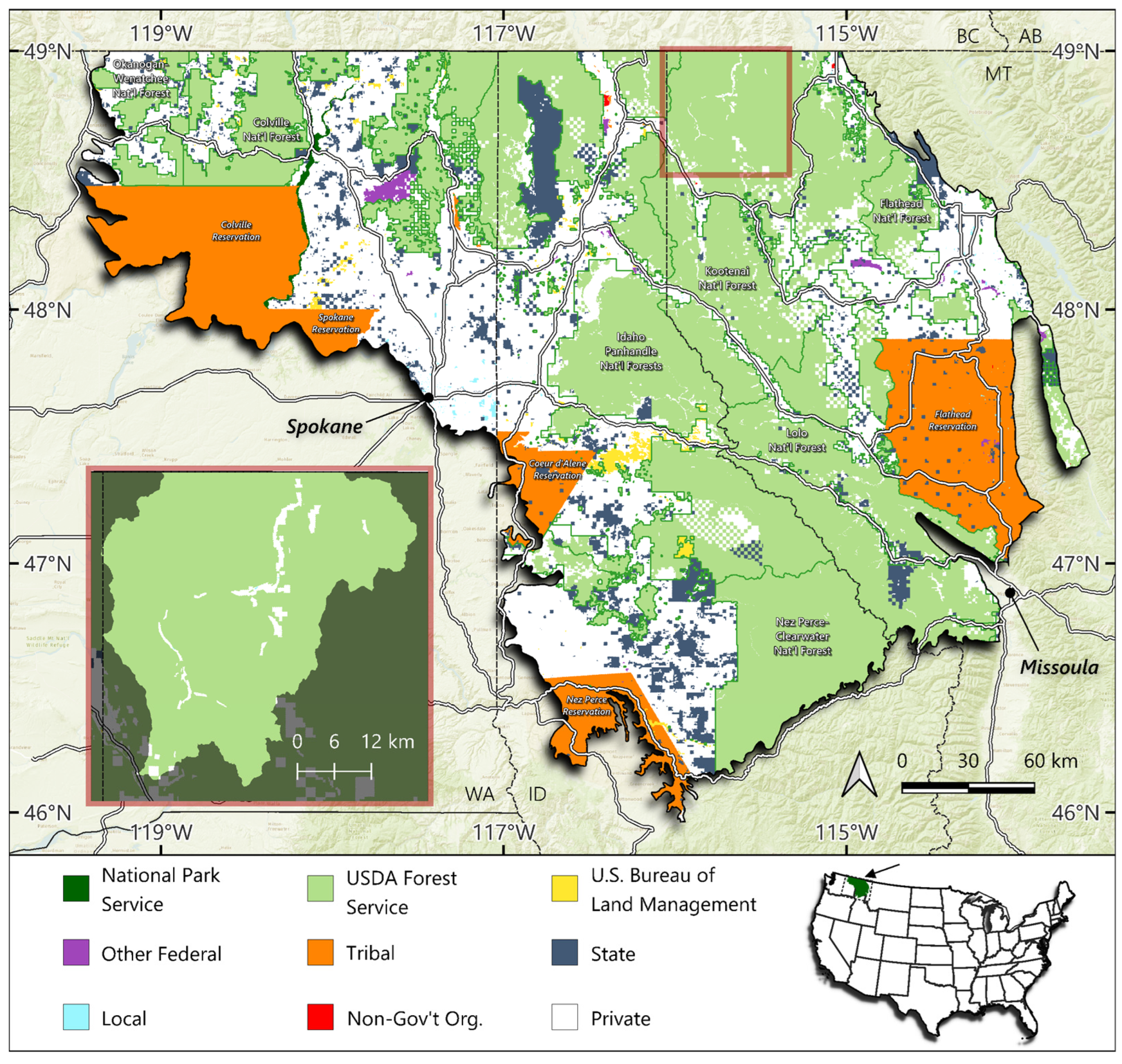
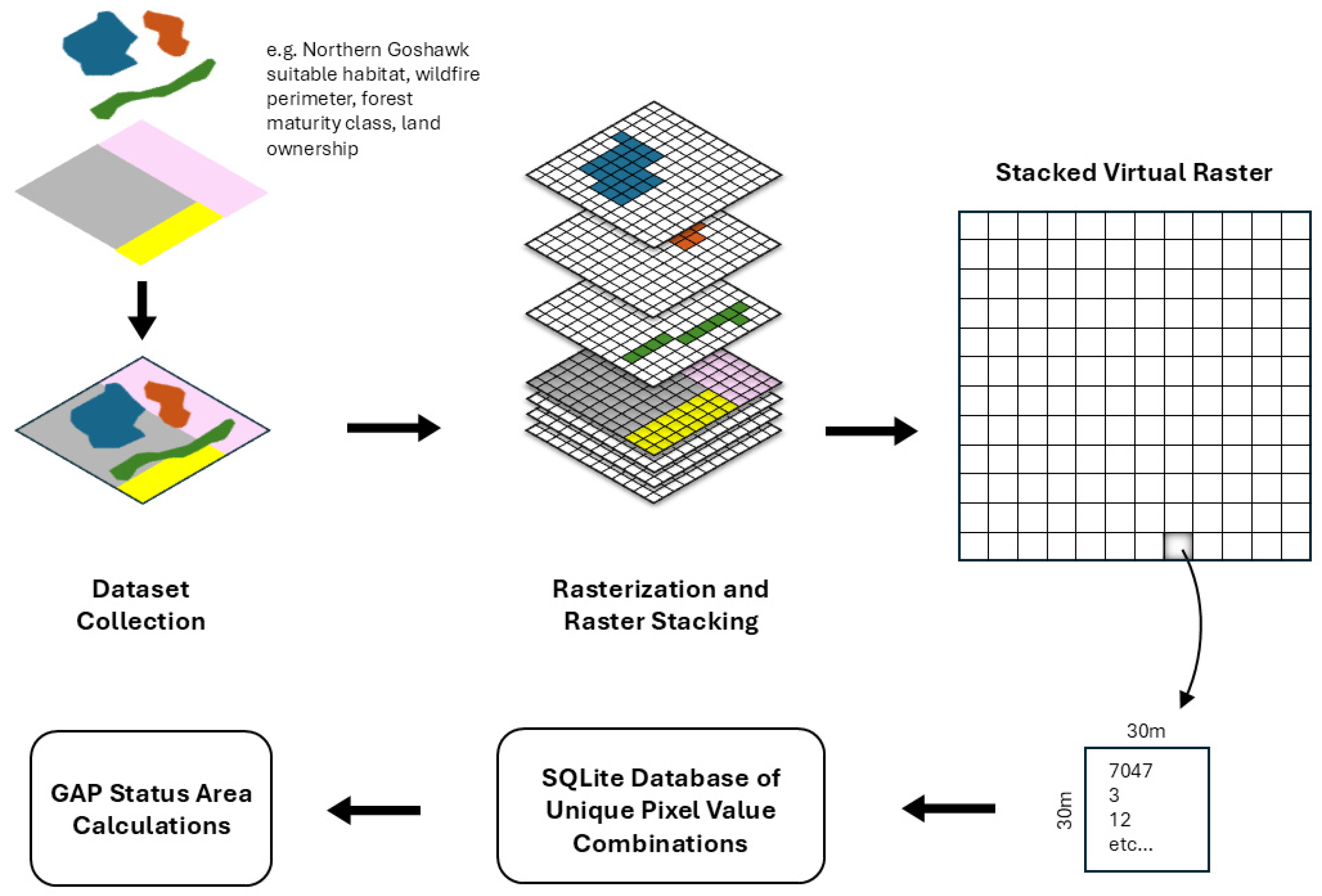
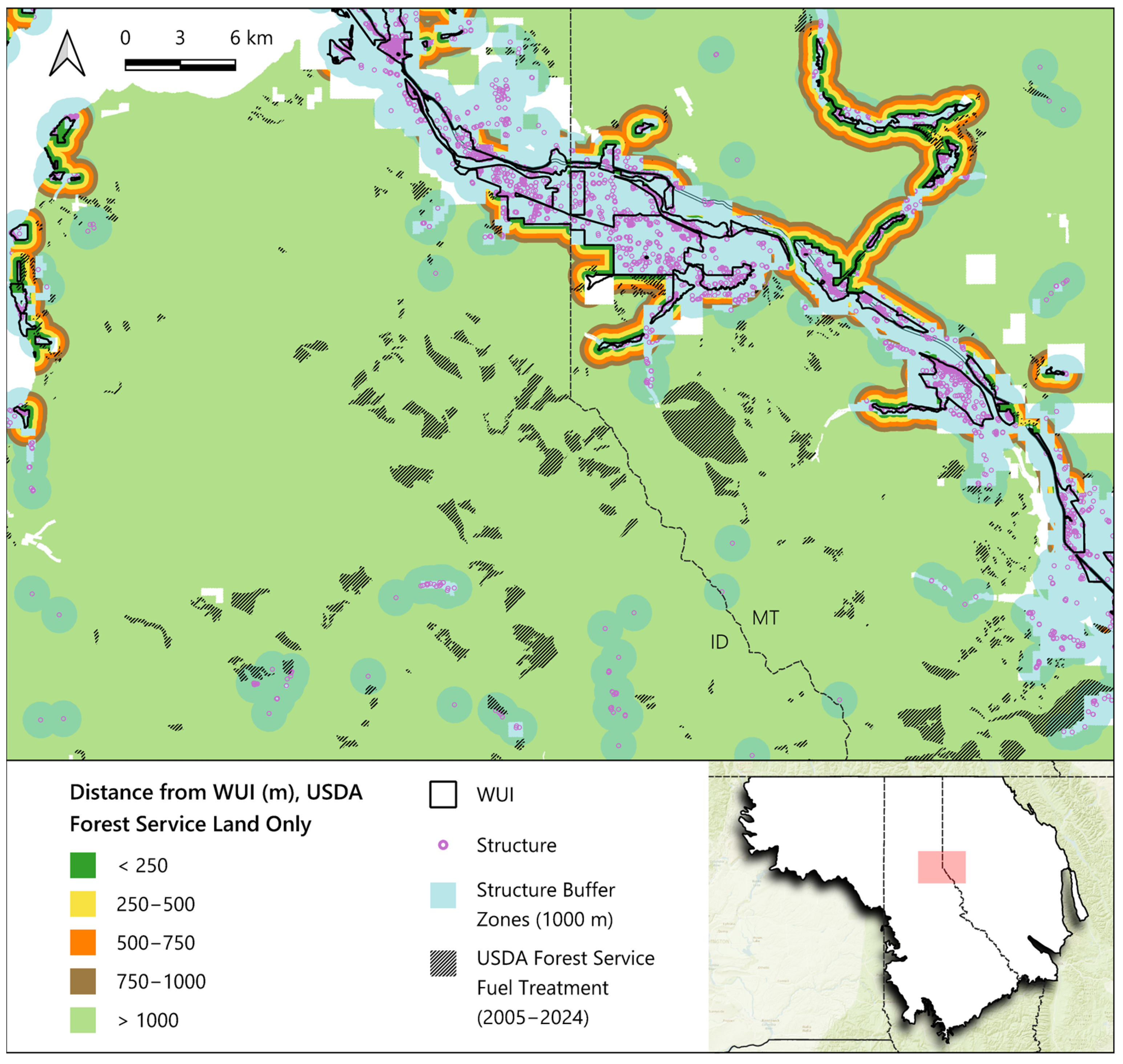
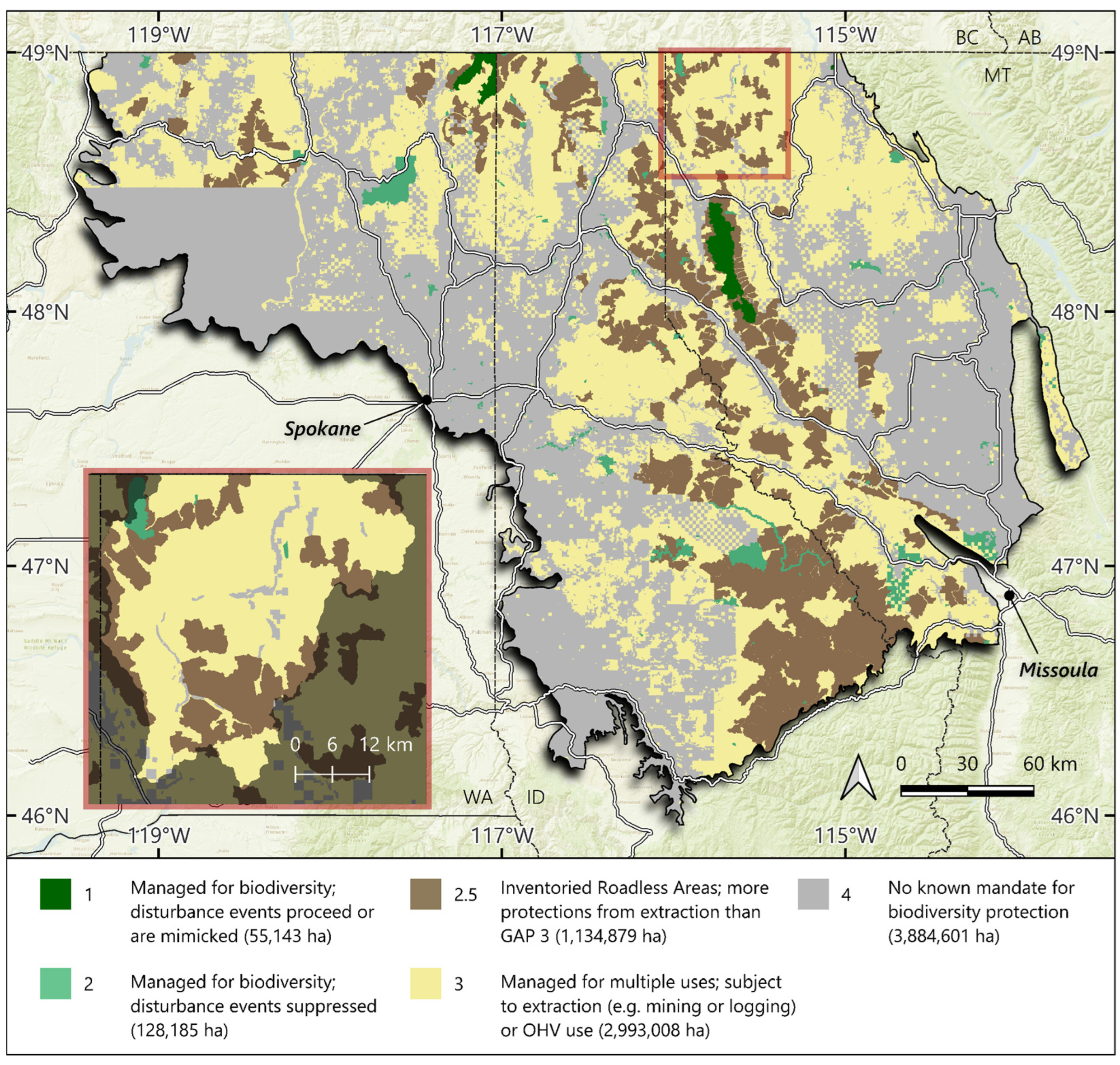
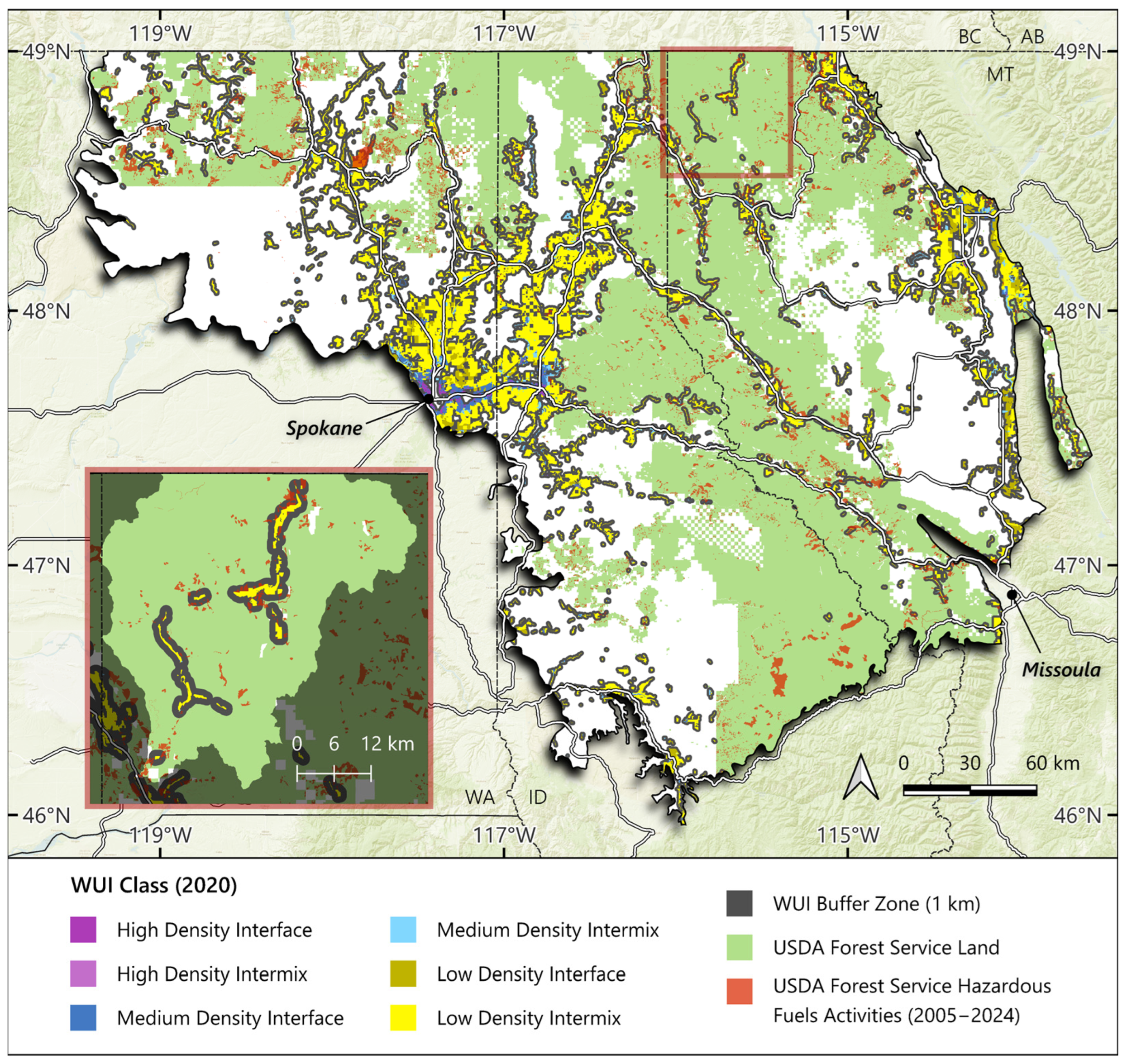
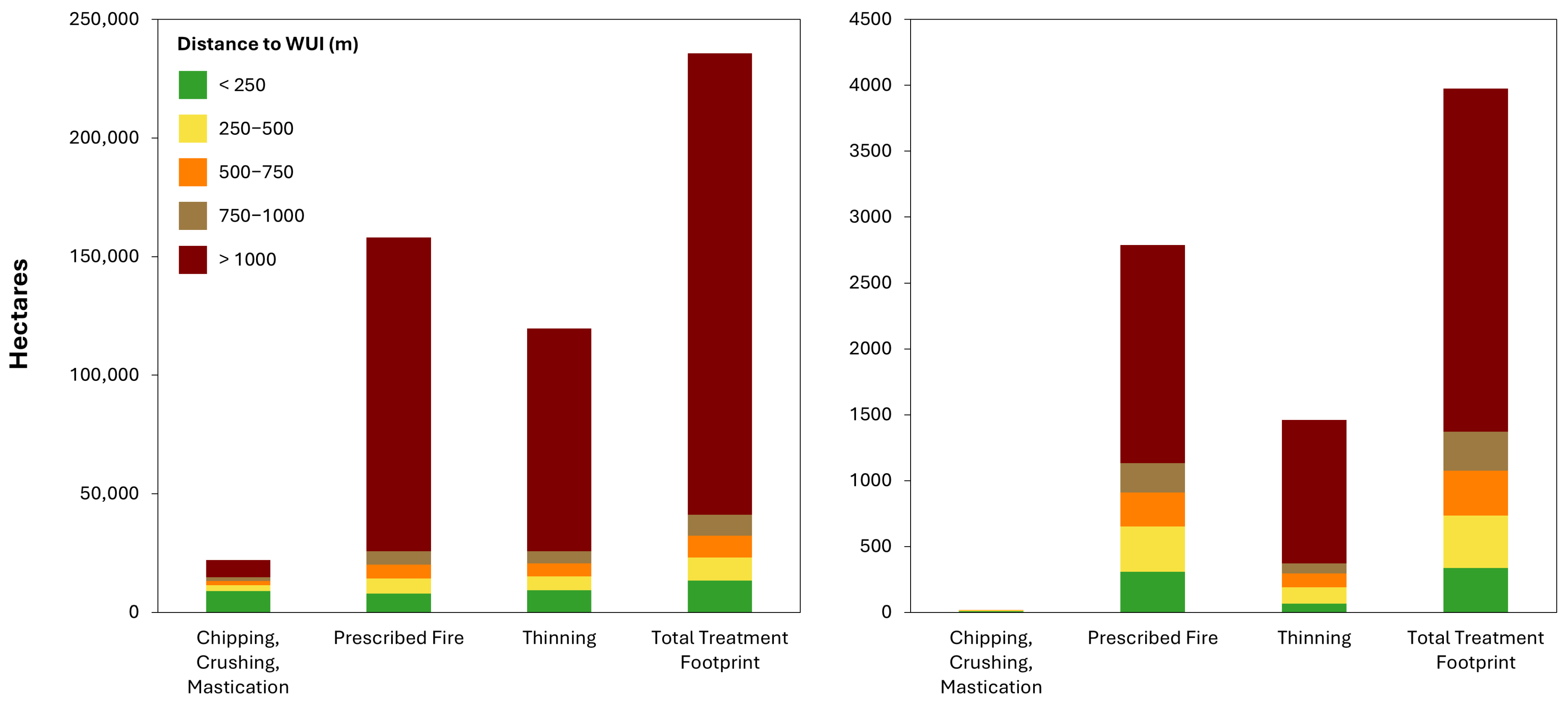

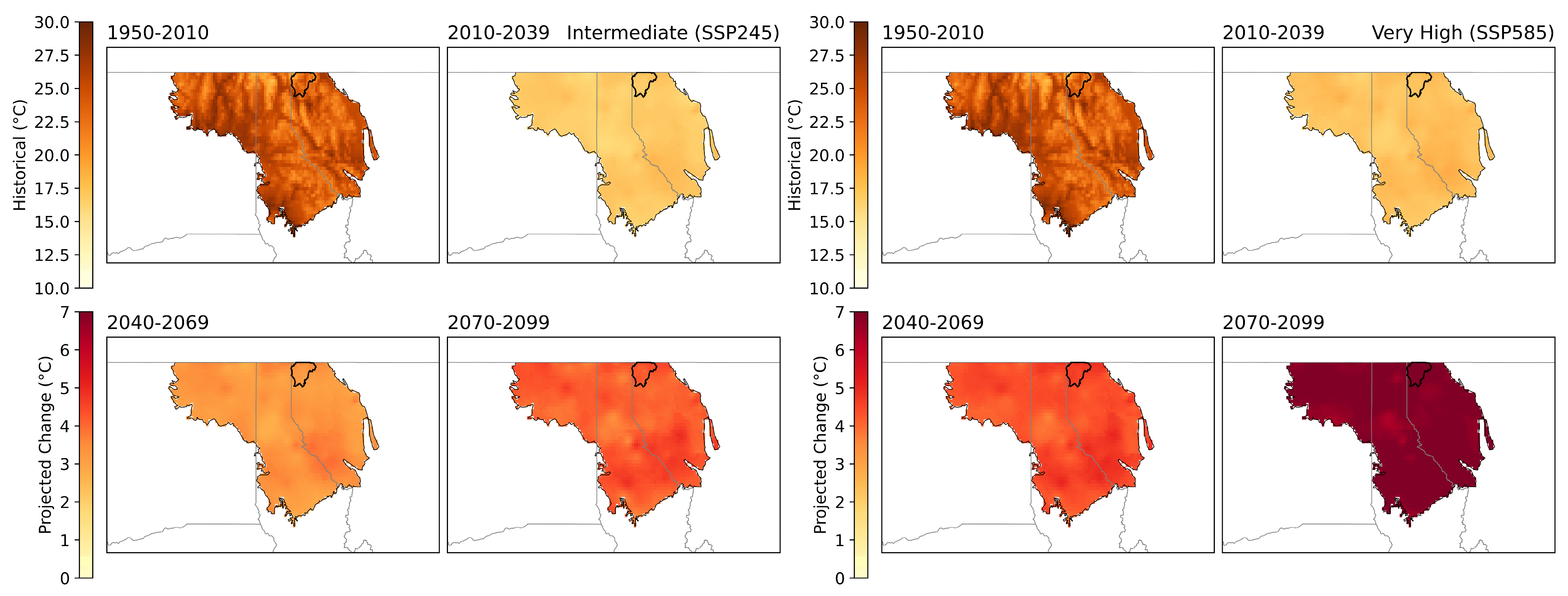
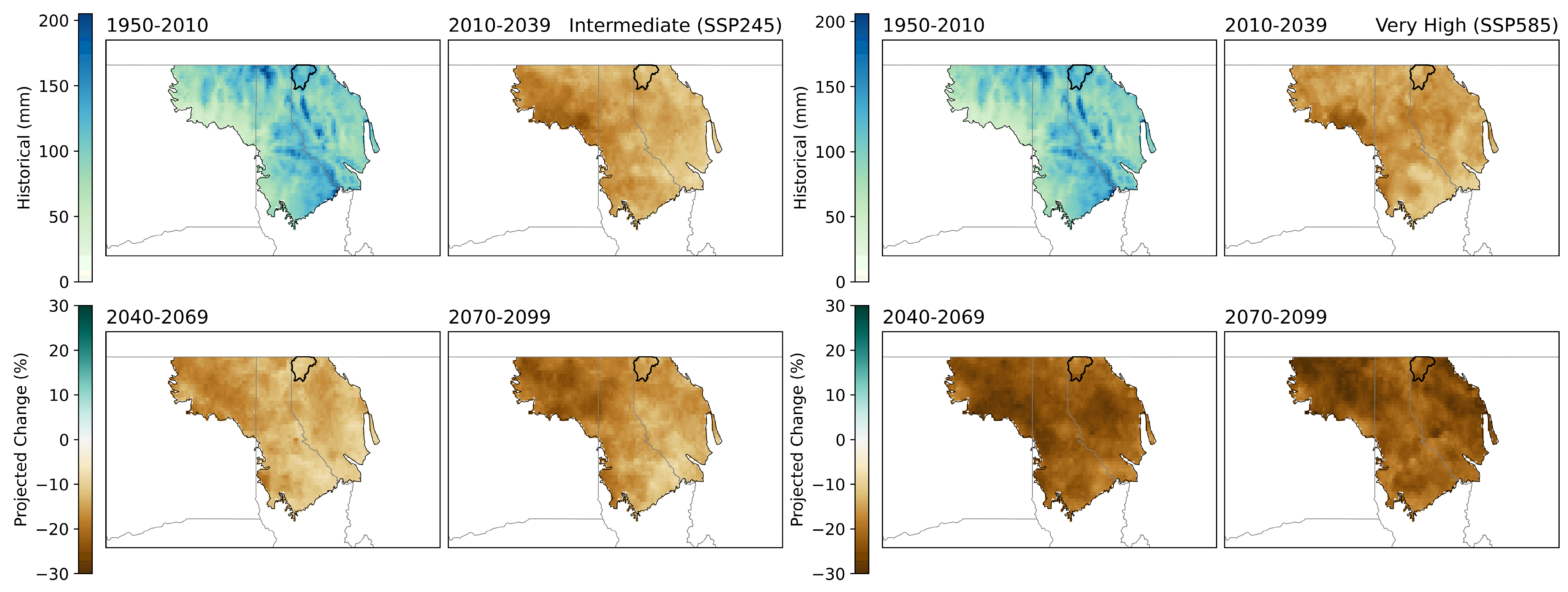
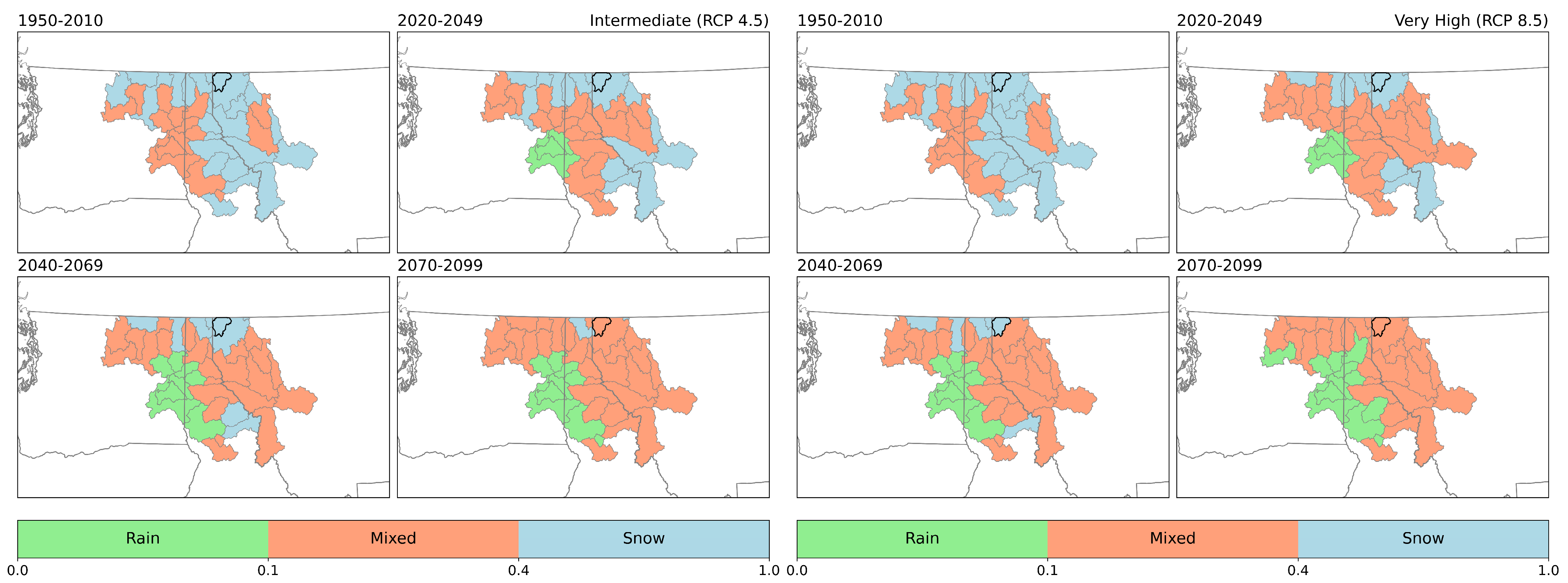
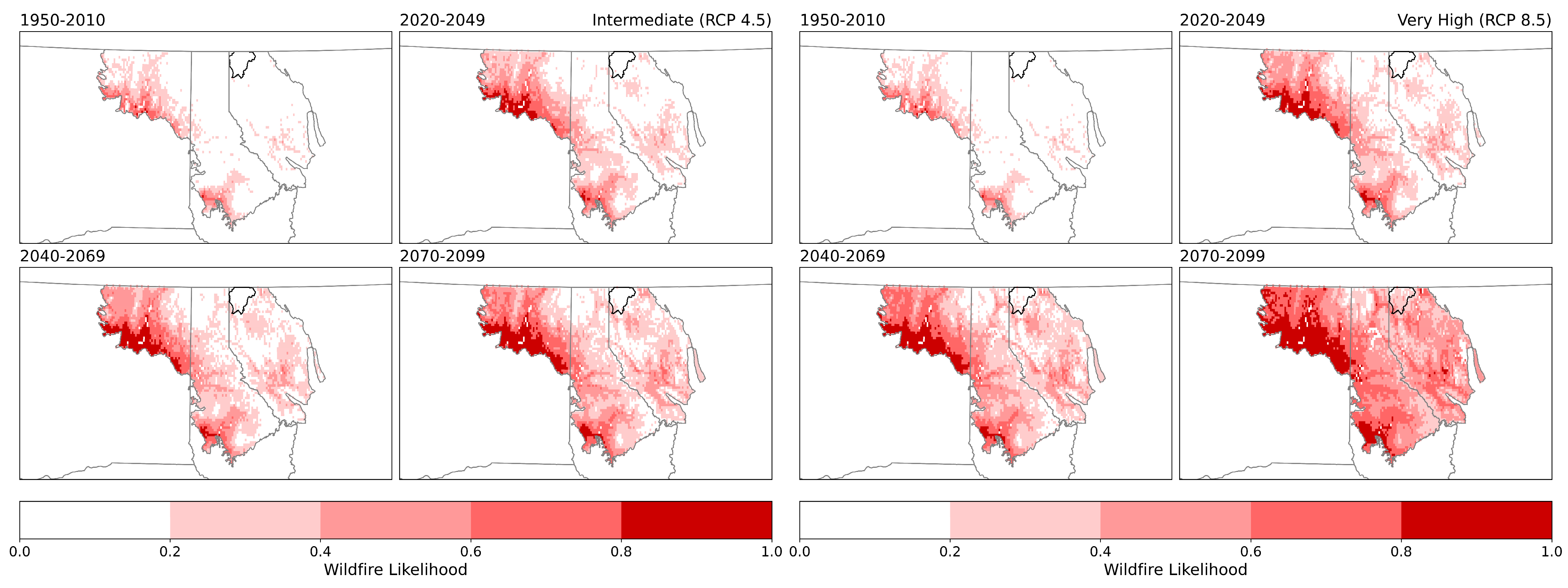
| EVT Category | NRE | YRW | ||
|---|---|---|---|---|
| Protected | IRA+ | Protected | IRA+ | |
| Agricultural and Developed | 7905 | 8452 | 0 | 3 |
| (1.0) | (1.1) | (0.0) | (0.2) | |
| Aspen | 11 | 25 | 0 | 0 |
| (1.5) | (3.2) | (0.0) | (0.0) | |
| Dry–Mesic Mixed Conifer | 31,218 | 232,763 | 55 | 6981 |
| (1.4) | (10.3) | (0.2) | (22.1) | |
| Grassland | 4988 | 23,621 | 41 | 417 |
| (1.6) | (7.8) | (3.0) | (30.4) | |
| Lodgepole Pine | 7636 | 101,244 | 11 | 2612 |
| (3.2) | (42.8) | (0.2) | (42.0) | |
| Mesic Mixed Conifer | 48,518 | 482,055 | 105 | 14,494 |
| (2.2) | (21.5) | (0.1) | (19.4) | |
| Open Water | 4323 | 6156 | 16 | 35 |
| (2.0) | (2.9) | (3.9) | (8.3) | |
| Other Conifer | 51 | 366 | 0 | 3 |
| (0.4) | (3.0) | (0.0) | (7.4) | |
| Ponderosa Pine | 7145 | 16,176 | 0 | 74 |
| (1.4) | (3.1) | (0.0) | (8.7) | |
| Riparian | 4583 | 10,655 | 53 | 258 |
| (2.8) | (6.5) | (2.0) | (9.9) | |
| Shrubland | 19,588 | 106,346 | 327 | 1958 |
| (2.5) | (13.5) | (7.9) | (47.2) | |
| Subalpine | 37,923 | 303,413 | 962 | 19,407 |
| (6.7) | (53.8) | (2.7) | (55.2) | |
| Unvegetated or Sparse | 5902 | 20,788 | 70 | 254 |
| (11.6) | (40.8) | (17.8) | (64.9) | |
| Western Larch | 427 | 2849 | 0 | 101 |
| (1.5) | (9.9) | (0.0) | (18.8) | |
| Wetland | 3109 | 3297 | 2 | 5 |
| (12.5) | (13.3) | (0.8) | (1.7) | |
| Total ha | 183,327 | 1,318,207 | 1642 | 46,601 |
| (% of total region area) | (2.2) | (16.1) | (1.0) | (29.2) |
| NRE | |||||
|---|---|---|---|---|---|
| Forest Type (EVT) | Total (ha) | Mature (ha) | Mature (%) | Protected Mature (%) | IRA+ Mature (%) |
| Aspen | 782 | 136 | 17.4 | 0.9 | 1.5 |
| Dry–Mesic Mixed Conifer | 2,269,618 | 530,783 | 23.4 | 1.4 | 13.9 |
| Lodgepole Pine | 236,792 | 33,282 | 14.1 | 3.3 | 55.4 |
| Mesic Mixed Conifer | 2,239,953 | 1,087,398 | 48.5 | 2.8 | 27.8 |
| Ponderosa Pine | 527,108 | 57,266 | 10.9 | 0.8 | 1.4 |
| Subalpine | 563,920 | 139,982 | 24.8 | 4.6 | 53.7 |
| Western Larch | 28,797 | 3095 | 10.7 | 1.5 | 18.4 |
| All Types | 5,866,971 | 1,851,943 | 31.6 | 2.4 | 25.5 |
| YRW | |||||
| Aspen | 0 | 0 | 0.0 | 0.0 | 0.0 |
| Dry–Mesic Mixed Conifer | 31,582 | 5963 | 18.9 | 0.5 | 23.9 |
| Lodgepole Pine | 6216 | 1093 | 17.6 | 0.2 | 49.1 |
| Mesic Mixed Conifer | 74,810 | 33,457 | 44.7 | 0.2 | 24.0 |
| Ponderosa Pine | 853 | 16 | 1.8 | 0.0 | 2.9 |
| Subalpine | 35,182 | 5262 | 15.0 | 0.2 | 51.9 |
| Western Larch | 537 | 16 | 3.0 | 0.0 | 34.3 |
| All Types | 149,180 | 45,806 | 30.7 | 0.25 | 27.8 |
| NRE | ||||||
|---|---|---|---|---|---|---|
| Habitat Suitability | GAP ha | Total ha | ||||
| (%) | ||||||
| 1 | 2 | 2.5 | 3 | 4 | ||
| Canada Lynx, Fisher, and Marten Overlap | 23,717 | 25,954 | 539,087 | 875,208 | 244,819 | 1,708,784 |
| (1.4) | (1.5) | (31.5) | (51.2) | (14.3) | ||
| All Forest Carnivore Species Overlap | 5063 | 2718 | 55,478 | 20,758 | 5363 | 89,379 |
| (5.7) | (3.0) | (62.1) | (23.2) | (6.0) | ||
| All Avian Species Overlap | 34,843 | 63,968 | 751,436 | 1,574,110 | 909,914 | 3,334,271 |
| (1.0) | (1.9) | (22.5) | (47.2) | (27.3) | ||
| Grizzly Bear Denning | ||||||
| Low | 10,394 | 23,447 | 404,046 | 629,870 | 201,745 | 1,269,502 |
| (0.8) | (1.8) | (31.8) | (49.6) | (15.9) | ||
| Medium | 21,919 | 13,964 | 349,485 | 174,816 | 32,895 | 593,079 |
| (3.7) | (2.4) | (58.9) | (29.5) | (5.5) | ||
| High | 19,681 | 4540 | 111,827 | 34,327 | 6198 | 176,572 |
| (11.1) | (2.6) | (63.3) | (19.4) | (3.5) | ||
| YRW | ||||||
| Canada Lynx, Fisher, and Marten Overlap | 0 | 787 | 24,680 | 51,815 | 542 | 77,823 |
| (0.0) | (1.0) | (31.7) | (66.6) | (0.7) | ||
| All Forest Carnivore Species Overlap | 0 | 552 | 2492 | 1033 | 0 | 4076 |
| (0.0) | (13.5) | (61.1) | (25.3) | (0.0) | ||
| All Avian Species Overlap | 0 | 1084 | 38,666 | 75,025 | 1979 | 116,755 |
| (0.0) | (0.9) | (33.1) | (64.3) | (1.7) | ||
| Grizzly Bear Denning | ||||||
| Low | 0 | 142 | 17,824 | 22,424 | 80 | 40,471 |
| (0.0) | (0.4) | (44.0) | (55.4) | (0.2) | ||
| Medium | 0 | 717 | 13,167 | 5574 | 105 | 19,563 |
| (0.0) | (3.7) | (67.3) | (28.5) | (0.5) | ||
| High | 0 | 561 | 3942 | 1134 | 10 | 5647 |
| (0.0) | (9.9) | (69.8) | (20.1) | (0.2) | ||
| Metric and Scenario | 1950–2010 | 2010–2039 | 2040–2069 | 2070–2099 |
|---|---|---|---|---|
| Growing Degree Days (Intermediate) | 637 °C-days (553 to 670) | +227 °C-days (162 to 557) | +391 °C-days (267 to 809) | +548 °C-days (324 to 886) |
| Growing Degree Days (Very High) | 637 °C-days (553 to 670) | +264 °C -days (141 to 572) | +590 °C-days (381 to 988) | +1021 °C-days (+603 to 1656) |
| Summer Mean Temperature (Intermediate) | 15.2 °C (14.4 to 15.4) | +1.9 °C (1.1 to 4.0) | +3.0 °C (1.8 to 5.7) | +4.0 °C (2.3 to 6.2) |
| Summer Mean Temperature (Very High) | 15.2 °C (14.4 to 15.4) | +2.1 °C (1.1 to 4.3) | +4.2 °C (2.8 to 6.8) | +6.9 °C (4.1 to 10.3) |
| Summer Precipitation (Intermediate) | 99 mm (91 to 109) | −16% (−27 to +7) | −13% (−33 to −3) | −18% (−43 to +10) |
| Summer Precipitation (Very High) | 102 mm (91 to 109) | −17% (−35 to +11) | −24% (−49 to +6) | −24% (−59 to +42) |
Disclaimer/Publisher’s Note: The statements, opinions and data contained in all publications are solely those of the individual author(s) and contributor(s) and not of MDPI and/or the editor(s). MDPI and/or the editor(s) disclaim responsibility for any injury to people or property resulting from any ideas, methods, instructions or products referred to in the content. |
© 2025 by the authors. Licensee MDPI, Basel, Switzerland. This article is an open access article distributed under the terms and conditions of the Creative Commons Attribution (CC BY) license (https://creativecommons.org/licenses/by/4.0/).
Share and Cite
DellaSala, D.A.; Africanis, K.; Baker, B.C.; Rogers, M.; Six, D. An Ecoregional Conservation Assessment for the Northern Rockies Ecoregion and Proposed Climate Refugium in the Yaak River Watershed, USA. Forests 2025, 16, 822. https://doi.org/10.3390/f16050822
DellaSala DA, Africanis K, Baker BC, Rogers M, Six D. An Ecoregional Conservation Assessment for the Northern Rockies Ecoregion and Proposed Climate Refugium in the Yaak River Watershed, USA. Forests. 2025; 16(5):822. https://doi.org/10.3390/f16050822
Chicago/Turabian StyleDellaSala, Dominick A., Kaia Africanis, Bryant C. Baker, Matthew Rogers, and Diana Six. 2025. "An Ecoregional Conservation Assessment for the Northern Rockies Ecoregion and Proposed Climate Refugium in the Yaak River Watershed, USA" Forests 16, no. 5: 822. https://doi.org/10.3390/f16050822
APA StyleDellaSala, D. A., Africanis, K., Baker, B. C., Rogers, M., & Six, D. (2025). An Ecoregional Conservation Assessment for the Northern Rockies Ecoregion and Proposed Climate Refugium in the Yaak River Watershed, USA. Forests, 16(5), 822. https://doi.org/10.3390/f16050822









